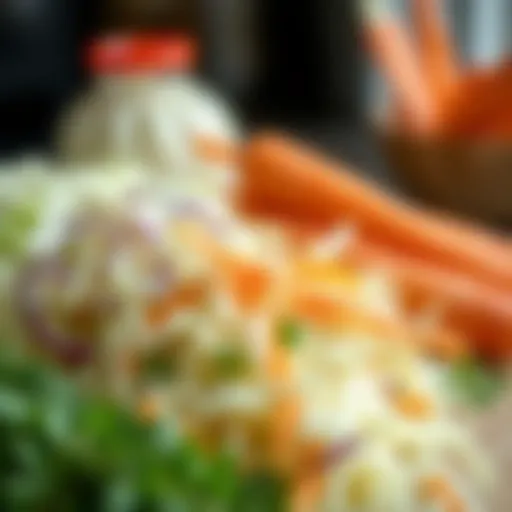Exploring the World of Carnival Cuisine: A Journey


Intro
Carnivals, the joyful cacophony of sights and sounds, have been celebrated for centuries across various cultures and regions, becoming synonymous with food that tantalizes the palate. As revelers flood the streets, the wafting aromas of sizzling, sweet, and spicy creations send taste buds into a frenzy, creating an irresistible culinary experience.
This article journeys through the vibrant world of carnival food, serving not just as a feast for the senses but also as a reflection of the history and culture behind these festivities. Each dish tells its own story, steeped in tradition yet often reimagined with modern twists. The fusion of local ingredients and cooking techniques highlights the distinctive flavors that resonate with participants and visitors alike, making these gatherings much more than mere entertainment.
In the following sections, we will explore popular dishes, regional variations, and the artistry behind preparation methods, providing a taste of how carnival cuisine has evolved over time. From the massive parades in Rio de Janeiro to the bustling streets of New Orleans, carnival food embodies a rich heritage waiting to be discovered.
Let us dive in, savoring each bite of this delectable narrative!
Understanding Carnival Food
When we talk about carnival food, we're diving into a fascinating blend of flavors, histories, and cultural narratives that shape our experience of festivals. This section explores why understanding carnival food is pivotal not just for food lovers, but also for anyone intrigued by the interplay of tradition and modernity in culinary landscapes.
Carnival food does not merely satisfy hunger; it carries stories from the past, evokes memories, and creates a sense of belonging among festival-goers. Each dish served during these lively gatherings offers a glance into the region's cultural fabric and the unique ingredients that are often sourced locally. Understanding this concept opens a window into not only what people eat during festivities but also why certain foods are cherished.
Defining Carnival Cuisine
At its core, carnival cuisine can be characterized by bold flavors and an array of vibrant ingredients. It's often a mixture of sweet and savory dishes, reflecting regional influences and seasonal produce. For instance, dishes like beignets at Mardi Gras in New Orleans or pavê during Brazilian carnivals showcase how food becomes a beacon of celebration.
Identifying carnival cuisine hinges on its celebratory nature. These foods are prepared in large quantities, encouraging sharing among friends and family. Here's a simple breakdown of key elements that define carnival cuisine:
- Accessibility: Carnival food is typically easy to prepare and serve, allowing for large crowds to be fed swiftly.
- Flavor Profile: Expect spicy, sweet, and savory flavors, often deep-fried or grilled.
- Cultural Significance: Dishes usually hold meaning tied to local traditions and historical events.
Festival seasons dictate the rhythm of food availability and choice, giving elements of creativity and adaptation to the chefs and home cooks involved. It's these defining features of carnival cuisine that anchor it in the hearts of many.
The Role of Festivals in Culinary Traditions
Festivals play a crucial role in shaping culinary traditions, acting as vibrant canvases where people come together to share not only food but also cultural identity. During carnivals, traditional dishes are often revived, passed down through generations, and blended with modern techniques to create something fresh yet familiar.
In many cultures, the foods served during festivals have their roots intertwined with historical events, religious practices, or seasonal changes. For example, Rosh Hashanah features honey-dipped apples symbolizing a sweet new year, while Diwali showcases sweets that signify prosperity.
Key points to consider regarding the influence of festivals on culinary practices include:
- Cultural Exchange: Festivals become melting pots where various cuisines blend, creating new food experiences that reflect communal identities.
- Seasonality: Many carnival foods use seasonal ingredients, prompting cooks to connect with local farmers and embrace fresh produce.
- Preservation of Tradition: Festivals often serve as opportunities to keep culinary traditions alive, preventing them from fading into obscurity.
Understanding how festivals influence culinary traditions helps forge deeper connections with the food we eat. Each dish carries echoes from the past, creating a rich tapestry of flavors and stories that deserve recognition.
As we explore these dimensions of carnival food, it's clear that they form an essential part of both our cultural heritage and contemporary culinary practices.
Historical Context
Understanding the historical roots of carnival food is vital for anyone looking to appreciate the culinary practices surrounding these vibrant celebrations. Many may think of carnival as mere indulgence, filled with joyous festivities and lively music, but at its core lies a rich historical narrative that intertwines communities, cultures, and traditions.
Throughout centuries, festivals have served as platforms to celebrate bountiful harvests and significant milestones. They also allowed communities to come together, showcasing their culinary heritage, which evolved over time. In this section, we explore the origins of these spirited celebrations, delving into how food has played a pivotal role.
Origins of Carnival Celebrations
Carnival celebrations can be traced back centuries, with roots in ancient rituals intended to welcome spring. These vibrant fiestas observed by different cultures often revolved around seasonal changes and agricultural cycles. For the Romans, the festival of Saturnalia, dedicated to the god Saturn, highlighted merriment. This time of revelry offered a refreshing escape from daily responsibilities.
In various regions, these early celebrations morphed through the influences of colonization, religion, and local customs. The essence of carnival transformed, incorporating unique flavors and practices unique to each culture. For example, the Mardi Gras festivities in New Orleans reflect a melting pot of African, French, and Spanish influences, creating a distinctive culinary landscape.
The carnival's historical trajectory underscores the importance of food as a communal element. During festivities, people contribute traditional dishes that carry stories, like gumbo or king cake, enhancing the sense of belonging.


As time moved on, these celebrations became more elaborate—intertwining joyous gatherings with spiritual significance. Thus, food not only represents sustenance; it symbolizes cultural identity and shared memories among participants.
Culinary Evolution Over Time
The journey of carnival cuisine has seen its fair share of transformations over the years, influenced by societal change and globalization. Historically, carnival foods reflected the bounty of communities—ingredients were sourced locally, making the best use of seasonal harvests.
In many cultures, indulgence is a hallmark of carnival cuisine. The period preceding Lent has historically been about enjoying rich, often decadent foods before the fasting season commences. This pattern still resonates, seen in the excessive portions and creativity of the snacks served during carnival time.
Some notable trends in the evolution include:
- Fusion of Flavors: As communities and cultures mixed, dishes began to reflect multiple heritages. For instance, Brazilian street food during the festival draws from Indigenous, African, and European roots.
- Healthier Adaptations: Recent years have seen a shift towards incorporating whole grains and organic ingredients into traditional recipes, reflecting a growing concern for health among festival-goers.
- Innovative Cooking Techniques: With advancements in technology, carnival foods are sometimes created using modern methods while ensuring the essence of traditional recipes remains intact.
As a result, the culinary landscape of carnival now serves not just as a means to celebrate but also a canvas for culinary innovation alongside preserving rich legacies. Understanding these nuances offers a deeper appreciation, revealing how carnival food captures the heart of shared experiences and cultural narratives.
"Food is an integral piece of the celebration puzzle, showcasing the stories and traditions that shape communities."
By exploring the historical context, one gains insight into how carnival cuisine transcends mere flavor, acting as a cultural marker within our evolving society. This showcases a panorama of authenticity while making space for new influences, creating a dynamic yet rooted culinary journey.
Popular Carnival Foods
Carnival food holds a special place not only in our stomachs but also in our hearts. It encapsulates a season of celebration, freedom, and community, serving as both a delicious indulgence and a cultural beacon. These foods are often tied to festivity and nostalgia, evoking memories of gatherings, parades, and joyous occasions. Their role in the carnival experience cannot be underestimated, as they bring people together, foster sharing, and create memorable moments that linger long after the festivities are over.
Classic Dishes and Their Relevance
Classic carnival dishes are often a symphony of flavors and textures that not only satisfy hunger but also tell a story of tradition and heritage. From deep-fried funnel cakes dusted in powdered sugar to savory corn dogs that encapsulate the spirit of fairgrounds, these staples encapsulate the essence of carnival. The relevance of these dishes lies in their ability to connect generations; they remind us of simpler times, making them a crucial part of the cultural fabric surrounding carnival festivities.
Regional Variations of Carnival Cuisine
The wide array of carnival foods reflects the specific regional traditions and flavors that define the celebrations in different areas. Let's take a closer look at three prominent variations that showcase the beautiful diversity in carnival cuisine.
Southern United States
Carnival food in the Southern United States is a delightful mix of rich flavors and hearty portions. Known for its emphasis on fried foods, typical dishes like fried catfish, jambalaya, and peach cobbler dominate the scene. One remarkable aspect of Southern carnival cuisine is its strong community ties; food stands are often run by local families, bringing an element of hometown pride to every dish served. The use of local ingredients, such as fresh seafood and locally grown produce, strengthens this connection to the region.
The unmistakable aroma of Southern cooking wafts through the air during carnival season, beckoning festival-goers to indulge in comfort food that nourishes both body and soul. However, the heavy nature of these dishes means they are often enjoyed in moderation, reminding revelers to savor rather than devour.
Brazilian Festas
Brazilian festas bring an infectious energy and vibrant culture that spins through its carnival offerings. Dishes such as feijoada, a black bean stew with a variety of meats, and pão de queijo, cheesy bread rolls, are staples found at these lively events. The key characteristic of Brazilian carnival food is its emphasis on both flavor and festivity, where each plate served is accompanied by laughter and music.
The unique advantage of Brazilian festas is the manner in which they meld flavors from African, Portuguese, and Indigenous influences, resulting in a culinary experience that's hard to replicate. However, the richness of these dishes might deter some from trying new options, as they can present a challenge to the more delicate palate.
European Carnivals
European carnivals often exhibit a dazzling array of traditional dishes that vary significantly by country, but one common thread runs through them: the joy of communal eating. From Italy's savory arancini (fried rice balls) to Germany's indulgent sauerkraut and sausages, each dish reflects the unique history of its region. The exceptional characteristic of European carnivals is their historical significance; many dishes have deep roots, dating back hundreds of years as part of seasonal celebrations.
These festivals can serve as a cultural bridge, allowing people from various backgrounds to discover and appreciate the local cuisine. The downside, however, can be the high levels of fat and carbs in many classic dishes, which can be off-putting for those seeking lighter options. Ultimately, the diversity of European carnival food invites festival-goers to broaden their culinary horizons while honoring time-honored traditions.
"Food plays a pivotal role in connecting people during celebrations—carnival foods are not merely dishes; they are vibrant expressions of culture and tradition."
Through exploring these different regional variations, one truly grasps the essence of carnival cuisine and its ability to celebrate not only food but also community, identity, and shared joy.
Ingredients at the Heart of Carnival Food
When it comes to carnival food, the ingredients are like the vibrant colors in a painting, each adding a distinct touch to the final masterpiece. These ingredients aren't just for sustenance; they carry stories, traditions, and cultural heritage behind every bite. The heart of carnival cuisine is its focus on incorporating fresh, local, and often seasonal ingredients which are pivotal in creating dishes that resonate with both locals and visitors alike.


Key Ingredients and Their Significance
Every carnival is a celebration of life, and the ingredients chosen for the foods prepared during these festivities reflect that exuberance. For instance, consider the prominence of corn in Southern United States carnivals. Cornbread, corndogs, and even corn on the cob are more than just dishes; they symbolize community gatherings and agricultural roots. The savoriness of a perfectly grilled corn on the cob with a hint of butter and sprinkle of salt can evoke memories tied to summer celebrations.
Similarly, in Brazil, the use of cassava is noteworthy during Carnival. From farofa to tapioca, cassava roots add texture and flavor, representing the diversity of Brazilian culture. In a way, selecting ingredients like these honors the agricultural practices that have been passed down through generations.
"Food is much more than fuel; it can be a cultural identity that transcends borders."
These ingredients aren’t just randomly picked – each serves a purpose, often linked to seasonality. At carnival time, it’s common to see dishes featuring citrus fruits, which symbolize freshness and vitality, turning mundane recipes into extravagant delights. Think of how vibrant oranges and limes can ignite a dish with tanginess, making it a feast for the senses.
The Use of Local Produce and Flavors
Local produce is often the cornerstone of carnival food, showcasing the flavors that are unique to a region. This connection not only enhances the taste but strengthens community ties between farmers and chefs. For example, take a look at the pimientos de padrón served during Spanish festivals. These peppers, fried until blistered with a sprinkle of sea salt, reflect the simplicity of local ingredients yet pack a delightful punch of flavor.
In coastal regions, seafood becomes the star of many carnival dishes. Imagine savoring fresh shrimp po’boys at a Louisiana festival; their flavor tells a tale of local waters and tradition. This serves as a reminder of the abundance from the ocean that brings communities together.
Utilizing ingredients local to the area also aligns with the principles of sustainability and environmental consciousness. When food is sourced from nearby farms, it not only reduces carbon footprints but also encourages the support of local economies. Delicious and ethical, this approach yields not just culinary experiences but also strengthens cultural bonds through food.
Festive Preparation Techniques
Celebrations around the world often draw their energy from the food that accompanies them. Carnival food is no exception. The way meals are prepared during these festivals is not just about the flavors; it's deeply entwined with the traditions and the spirit of the occasion. Understanding these preparation techniques enhances our appreciation of the dishes that come to life during these vibrant gatherings.
Traditional Cooking Methods
When we think of traditional cooking methods, images of open flames, stone ovens, and communal cooking often spring to mind. For carnival celebrations, these methods aren't merely nostalgic; they also add distinct flavors and textures to the food.
For instance, deep-frying is a staple for many carnival dishes. Whether it’s beignets in New Orleans or churros in Spain, the sizzling water or oil creates a crunch that is simply emblematic of the festival spirit.
In parts of Brazil, open grilling is quite common, particularly with meats. The practice of asalga involves marinating meat in a mix of spices before grilling it over flaming coals. This method not only imbues the meat with rich flavor but often brings people together around the grill in a communal atmosphere.
Here are some key traditional techniques seen in carnival food preparation:
- Smoking: Used in Caribbean carnivals, meats and fish are smoked to enhance their flavor while ensuring preservation.
- Fermentation: Dishes like sauerkraut or kimchi may find their place in certain festivals, linking the food to historical preservation methods.
- Steaming: A technique that retains nutrients while allowing flavors to meld together, seen in several Asian carnivals.
These methods are vital, as they turn the cooking into part of the event—often made in large quantities, inviting participation from various community members.
Contemporary Approaches to Classic Recipes
As society evolves, so too does the culinary landscape of carnival food. Today's chefs are continuously finding ways to marry traditional techniques with modern sensibilities. Many are mindful not just of taste but of health, sustainability, and aesthetic presentation. This fusion encourages creative dishes while retaining their cultural roots.
Many chefs dive into the notion of fusion cuisine, blending various culinary influences and styles almost seamlessly. A traditional paella, for example, might adapt by incorporating quinoa instead of rice, catering to modern dietary preferences. This practice can breathe new life into classic dishes, making them appealing to younger generations who might prefer innovative flavors over the traditional styles.
Another trend is the exploration of plant-based adaptations. Dishes that once relied heavily on meat are being reimagined. Vegan jambalaya or plant-based tempura provide the same festive comfort but cater to a growing demand for healthier options. This practice not only highlights the versatility of the original recipes but also reflects changing cultural attitudes toward food.
Key points to note regarding contemporary approaches include:
- Health-conscious offerings: Modification of recipes to eliminate excessive calories and unhealthy ingredients.
- Presentation as an art: Enhanced plating and creativity make dishes more visually appealing, attracting a broadened audience.
- Inclusion of technology: Tools like sous-vide can help chefs achieve precise results, enabling an entirely new era in food preparation during festivals.
"Carnival food is more than just a meal; it’s a shared experience, a way for communities to connect over flavors that tell their stories.
The Cultural Impact of Carnival Food
Carnival food is not just about flavor; it’s a tapestry woven from various threads of tradition, social interactions, and cultural heritage. This aspect of culinary expression offers an array of insights into how food resonates with the community spirit, the values of society, and even socio-political dimensions. As festivals bring people together, the types of foods shared during these celebrations reflect deeper meanings and serve as a lens through which we can view our shared humanity.
Social Aspects of Sharing Food During Festivals
When we think of a carnival, the whirling lights, joyous laughter, and vibrant costumes spring to mind. But amidst all the revelry, food becomes a powerful medium for connection. It is almost magical how sharing a meal can turn strangers into friends and family into a closer-knit community. At festivals, people often gather around food stalls, exchanging stories while enjoying their favorite treats.


- These communal dining experiences offer more than just sustenance; they create bonds between individuals and reinforce social networks.
- Traditional foods often carry with them the histories and stories of the community, instilling a sense of pride.
- Whether it’s tamales in Mexico, beignets in New Orleans, or churros in Spain, each dish has a narrative, layering the culinary heritage with personal memories.
"Food is not what you eat, but what you share."
This saying encapsulates the essence of carnival celebrations where food becomes a cherished medium of interaction, contributing to collective joy and remembrance.
In many cultures, the preparation and consumption of carnival food are laden with customs; for instance, the practice of cooking large portions to share signifies abundance and hospitality. It becomes a collective effort, where families and friends come together, each lending a hand to create cherished dishes. This leads to the unspoken understanding that food shared is love delivered, fostering deeper relationships.
Food as a Reflection of Cultural Identity
Food serves as a mirror, reflecting the intricacies of cultural identity during carnival gatherings. Each dish is a story waiting to be told, transcending the taste buds and captivating the soul. Festivals celebrate not only local ingredients and traditional recipes but also the myriad influences that shape a community.
- Regional specialties often highlight the agricultural strengths of an area, allowing foodies to taste the very essence of the landscape.
- Carnival cuisine can blend various influences as seen in the Caribbean, where African, European, and Indigenous practices meld into one delightful platter that tells the story of a multi-faceted culture.
In many ways, carnival food is about recognition; it's a way for cultural narratives to be acknowledged and valued. Dishes like Italian carnival fritters or Brazilian feijoada give participants a taste of history, cultural resilience, and adaptation. It allows communities to assert their identities and bonds that have withstood the test of time.
This cultural richness is especially poignant in global festivals, where food becomes a vehicle for cultural exchange, introducing diversity and fostering respect among varying traditions. In an increasingly homogenized world, celebrating unique culinary traditions serves as a reminder of our shared humanity, enhancing appreciation for different customs and tastes.
In summary, the cultural impact of carnival food reveals not just the flavors of a festival but also the rich tapestry of social interactions and cultural identities that it fosters. The act of sharing and celebrating food during these gatherings brings communities together, emphasizes historical narratives, and honors the values that encapsulate our collective experiences.
Contemporary Trends in Carnival Cuisine
Contemporary carnival cuisine is not merely a reflection of tradition; it also embodies the dynamic spirit of our ever-changing world. This trend is significant for it showcases the adaptability of carnival food, proving that culinary practices can evolve while still honoring their roots. In a time when health consciousness and global influences dominate dining preferences, carnival food is experiencing a renaissance that bridges the gap between age-old recipes and modern palates. This section will explore the two prominent trends: fusion dishes and health-conscious adaptations, both pivotal in shaping the current carnival food landscape.
Fusion Dishes and Global Influences
Fusion dishes in carnival food represent a delightful marriage of flavors from varied cuisines. This blending not only caters to diverse tastes but also reflects the reality of our globalized society. Imagine biting into a spicy jambalaya spring roll or savoring paella nachos topped with a zesty chimichurri. These innovative combinations invite food lovers to step out of their comfort zones and experience a fusion of cultures served up on plates.
The rise of social media has played a key role in this culinary evolution. As more festival-goers share their unique food sightings online, chefs are compelled to push culinary boundaries. This engagement can lead to a more participatory experience. Fans of carnival festivities often find themselves excited to try newly crafted dishes that combine the essence of their favorite traditional foods with unexpected twists.
"Carnival food is a reflection of our collective palate; it speaks to where we have been and where we are going."
Moreover, regional crops and ingredients are now being incorporated into internationally inspired dishes. For instance, chefs might create a Caribbean-Asian bowl featuring local root vegetables from the region, paired with tamarind sauce. This trend not only enhances the flavor profile but also supports local economies by utilizing seasonal produce.
Health-Conscious Adaptations of Traditional Dishes
Health-conscious adaptations of traditional carnival dishes are emerging as a central theme in the evolution of these culinary delights. As people become more aware of their eating habits, chefs are rethinking heavily fried or processed offerings. You might come across a stall serving quinoa-stuffed corn fritters or zucchini-based fried pastries instead of their traditional counterparts. These modifications not only satisfy the cravings of health-conscious festival-goers but also introduce fresh flavors and textures to familiar dishes.
In the realm of desserts, traditional sugary treats are also getting a makeover. For example, instead of deep-fried doughnuts laden with powdered sugar, you could find baked doughnut holes made with almond flour and agave syrup. Such adaptations minimize the caloric burden while still allowing enjoyment of carnival sweets.
Another noteworthy aspect is the increased focus on plant-based options. Vegan variations of popular carnival items, like black bean sliders or jackfruit barbecue tacos, offer a satisfying alternative that caters to the growing demand for plant-based diets. It shows that even during lively festivities, there’s room for wholesome ingredients.
The Future of Carnival Food
The landscape of carnival food is evolving, presenting both challenges and opportunities for culinary traditions. As society becomes increasingly aware of environmental issues, the future of carnival cuisine hinges upon embracing sustainability and innovation. This shift is not merely a response to the changing preferences of food lovers, but a necessity to ensure the longevity of these important cultural practices.
Sustainability in Carnival Food Practices
Sustainability isn’t just a buzzword anymore; it’s becoming the cornerstone of modern food practices, including carnival cuisine. Here are a few key factors influencing sustainable approaches:
- Seasonal Ingredients: Relying on local and seasonal produce is a prominent trend. Ingredients are fresher and taste better, providing a vibrant flavor profile to carnival dishes. When a community incorporates local fruits, vegetables, and meats, it not only supports local farmers but also minimizes carbon footprint.
- Waste Reduction: Traditionally, carnival food triggers joy and celebration, but it can also contribute to substantial waste. Many organizers now emphasize reducing waste through composting, recycling, and using biodegradable materials for serving food. Minimizing food waste is crucial; some festivals have even launched programs to donate surplus food to local shelters.
- Ethical Sourcing: The ethical treatment of animals and workers has sparked a vital conversation among food enthusiasts. Carnival vendors who source their ingredients from farms that adhere to ethical practices not only raise the quality of their food but also build a stronger relationship with their community.
"The choices we make today about where our food comes from will shape the celebrations of tomorrow."
Implementing these sustainable practices ensures future generations can indulge in the same rich and diverse carnival foods that today’s festivities offer.
Embracing Technology in Food Preparation
As carnival environments grow larger and more dynamic, leveraging technology in food preparation has become a noteworthy development. Embracing tech can enhance how traditional carnival foods are made and presented:
- Advanced Cooking Techniques: Sous-vide cooking and other technological innovations allow chefs to perfect their dishes, ensuring texture and flavor are consistently top-notch. These methods capture the authenticity of carnival foods while also speeding up preparation time.
- Online Ordering and Delivery: Many food vendors have turned to technology to streamline processes for the modern consumer. Festivals can set up apps that allow visitors to order meals in advance. This not only reduces long lines but also allows vendors to manage supplies better, prevent waste, and provide a more customized experience.
- Social Media Integration: Today's carnival experience is as much about sharing on social media as it is about the food itself. Vendors are harnessing platforms like Instagram and Facebook to promote their dishes, share videos of the cooking process, or engage in live tastings.
With such advancements shaping the future of carnival food, it is clear that technology can enhance the way communities celebrate culinary traditions. The combination of sustainability and technological integration presents a vibrant future where carnival cuisine continues to thrive, evolve, and delight food lovers of all generations.















